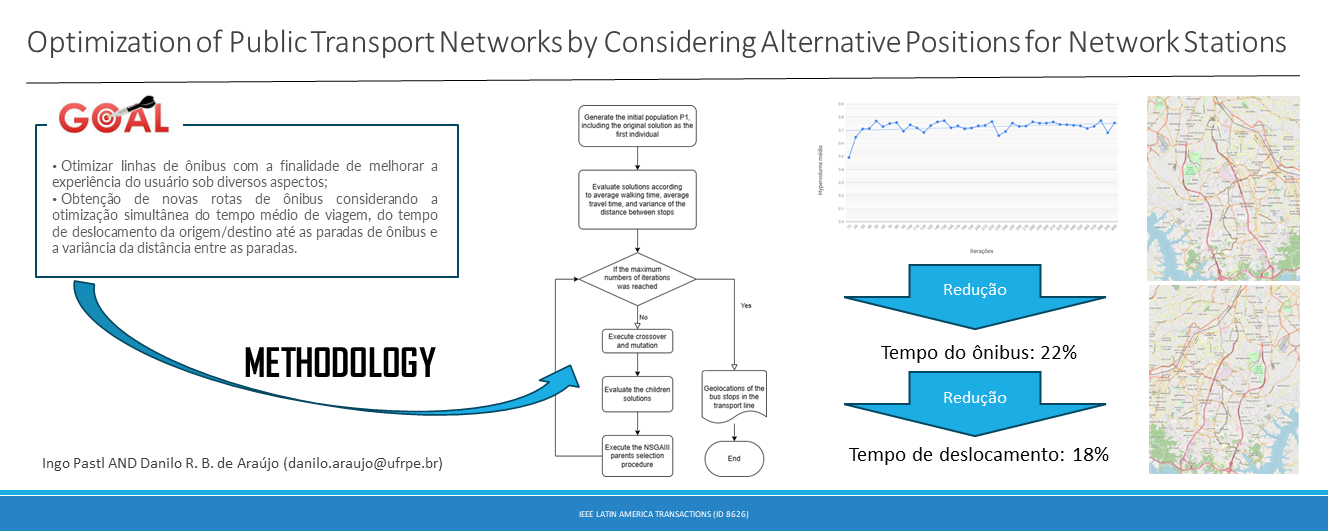Optimization of Public Transport Networks by Considering Alternative Positions for Network Stations
Keywords:
Public Transport Networks, Multiobjective Optimization, Evolutionary computationAbstract
Netheradays planning of metropolitan areas considers to improve quality of life of their inhabitants and urban
mobility is one of the main concerns. Studies point out that investments in public transportation and other modes are aimed
at the overall improvement of mobility. However, there is a gap in proper tools for optimizing public transport networks.
In fact, network optimization is an NP-Hard problem and there are usually many conflicting objectives that need to be
optimized simultaneously. This paper proposes the use of manyobjective evolutionary algorithms to address the problem of
public transport networks optimization, focusing on metropolitan bus lines. The proposal consists in optimizing the position of bus stops and consequently obtaining new routes that pass through these stops in order to minimize the average travel time, the time spent between origin / destination and the variance of distance between the stops. To evaluate our proposal, a simulator was used to simulate the behavior of different passenger profiles in an urban area and the results were compared between the lines obtained by the optimization process and existing bus lines in the city of São Paulo. According to our results, optimized bus routes have mean travel time 22% less than the existing route and the time spent between origin/destination has decreased up to 18%.
Downloads
References
A. N. R. da Silva, M. da Silva Costa, and M. H. Macedo, “Multiple views of sustainable urban mobility: The case of brazil,” Transport Policy, vol. 15, no. 6, pp. 350–360, 2008.
L. Olsson, M. Friman, K. Lättman, and S. Fujii, “Travel and life satisfaction - from gen z to the silent generation,” Journal of Transport Health, vol. 18, p. 100894, 2020.
M. J. Nieuwenhuijsen, “Urban and transport planning pathways to carbon neutral, liveable and healthy cities; a review of the current evidence,” Environment International, vol. 140, p. 105661, 2020.
M. Friman, K. Lättman, and L. E. Olsson, “Public transport quality, safety, and perceived accessibility,” Sustainability, vol. 12, no. 9, 2020.
N. Banerjee and R. Kumar, “Multiobjective network design for realistic traffic models,” in Proceedings of the 9th Annual Conference on Genetic and Evolutionary Computation, GECCO ’07, (New York, NY, USA), p. 1904–1911, Association for Computing Machinery, 2007.
J. Candeias, D. R. de Araújo, P. Miranda, and C. J. Bastos-Filho, “Memetic evolutionary algorithms to design optical networks with a local search that improves diversity,” Expert Systems with Applications, vol. 232, p. 120805, 2023.
B. Li, J. Li, K. Tang, and X. Yao, “Many-objective evolutionary algorithms: A survey,” ACM Comput. Surv., vol. 48, sep 2015.
K. Deb, A. Pratap, S. Agarwal, and T. Meyarivan, “A fast and elitist multiobjective genetic algorithm: Nsga-ii,” IEEE Transactions on Evolutionary Computation, vol. 6, no. 2, pp. 182–197, 2002.
C. A. Coello Coello, C. Dhaenens, and L. Jourdan, Multi-Objective Combinatorial Optimization: Problematic and Context, pp. 1–21. Berlin, Heidelberg: Springer Berlin Heidelberg, 2010.
K. Deb and H. Jain, “An evolutionary many-objective optimization algorithm using reference-point-based nondominated sorting approach, part i: Solving problems with box constraints,” IEEE Transactions on Evolutionary Computation, vol. 18, no. 4, pp. 577–601, 2014.
I. Das and J. E. Dennis, “Normal-boundary intersection: A new method for generating the pareto surface in nonlinear multicriteria optimization problems,” SIAM Journal on Optimization, vol. 8, no. 3, pp. 631–657, 1998.
L. Bradstreet, “The hypervolume indicator formulti-objective optimisation: calculation and use,” The University of Western Australia, 2011.
E. Zitzler, L. Thiele, M. Laumanns, C. Fonseca, and V. da Fonseca, “Performance assessment of multiobjective optimizers: an analysis and review,” IEEE Transactions on Evolutionary Computation, vol. 7, no. 2, pp. 117–132, 2003.
SPTrans, “Gtfs - sp.” http://www.sptrans.com.br/desenvolvedores/ perfil-desenvolvedor/. Accessed: 2023-09-26.
G. LLC, “Google maps api.” https://mapsplatform.google.com/. Accessed: 2023-09-26.
M. Corporation, “Bing maps api.” https://www.microsoft.com/en-us/maps/bing-maps/choose-your-bing-maps-api. Accessed: 2023-09-26.
P. OSRM, “Osrm api.” https://github.com/Project-OSRM. Accessed: 2023-09-26.
M. V. A.J. Nebro, J.J. Durillo, “jmetal framework.”


